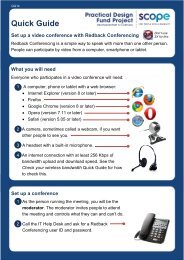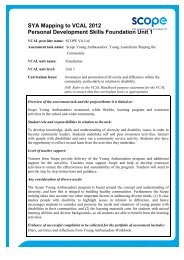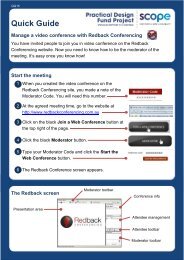Positive behaviour support Getting it right from the start
Positive behaviour support Getting it right from the start
Positive behaviour support Getting it right from the start
You also want an ePaper? Increase the reach of your titles
YUMPU automatically turns print PDFs into web optimized ePapers that Google loves.
<strong>Pos<strong>it</strong>ive</strong> <strong>behaviour</strong> <strong>support</strong>: <strong>Getting</strong> <strong>it</strong> <strong>right</strong> <strong>from</strong> <strong>the</strong> <strong>start</strong> - Facil<strong>it</strong>ators reference manual 65<br />
PowerPoint 92<br />
PowerPoint 93<br />
PowerPoint 94<br />
*<br />
*<br />
*<br />
Step 3: What message is <strong>the</strong> person communicating via <strong>the</strong> <strong>behaviour</strong><br />
of concern?<br />
Behaviours of concern serve a function or purpose for <strong>the</strong> person. The most common reasons<br />
people show <strong>behaviour</strong>s of concern are often <strong>the</strong> same as why all people communicate. An<br />
analysis of <strong>the</strong> <strong>behaviour</strong>al recording will have generated some ideas (hypo<strong>the</strong>ses) about <strong>the</strong><br />
function of <strong>the</strong> <strong>behaviour</strong> that is any patterns to <strong>the</strong> <strong>behaviour</strong>. Hypo<strong>the</strong>ses regarding <strong>the</strong><br />
function or relationship between <strong>the</strong> <strong>behaviour</strong> and <strong>the</strong> individual’s environment can lead to<br />
identifying pos<strong>it</strong>ive <strong>behaviour</strong> <strong>support</strong> strategies. Be aware however that a single <strong>behaviour</strong> of<br />
concern may serve more than one function.<br />
The function that a <strong>behaviour</strong> serves has direct implications for how we respond to <strong>the</strong><br />
<strong>behaviour</strong>. For example <strong>it</strong> could be decided to ignore a person who is engaging in <strong>the</strong> <strong>behaviour</strong><br />
of head banging. In <strong>the</strong> long term this may lessen <strong>the</strong> <strong>behaviour</strong> in a person who head bangs<br />
exclusively to gain social interaction. However <strong>the</strong> exact same strategy could worsen <strong>the</strong><br />
<strong>behaviour</strong> for ano<strong>the</strong>r person who bangs because <strong>the</strong>y prefer to stay alone, since this response<br />
may reinforce <strong>the</strong> <strong>behaviour</strong> that ‘I bang my head and people leave me alone’.<br />
In <strong>the</strong> above scenarios both people are communicating through <strong>the</strong>ir <strong>behaviour</strong>, that <strong>the</strong>y would<br />
like more or less attention and <strong>it</strong> is important to listen to this. However one must try and respond<br />
in a way that is not simply a direct reaction to <strong>the</strong> head banging.<br />
The following are some of <strong>the</strong> most common messages being communicated via <strong>behaviour</strong>s:<br />
• Gaining social interaction<br />
• Escape or avoidance of demands<br />
• Gaining access to preferred activ<strong>it</strong>ies or tangible objects<br />
• Sensory feedback (e.g. hand flapping, eye poking)<br />
• Pursu<strong>it</strong> of power and control over own life<br />
• Reduction of arousal and anxiety.<br />
Analysing <strong>the</strong> information you have collected using <strong>the</strong> STAR chart and <strong>the</strong> MAS; what<br />
messages do you think your focus person is trying to communicate.<br />
Why?<br />
PowerPoint 95<br />
*<br />
Analyse <strong>the</strong> STAR charts below, do you agree w<strong>it</strong>h <strong>the</strong> assessment of <strong>the</strong> function of <strong>the</strong><br />
<strong>behaviour</strong>s identified?<br />
What else could <strong>the</strong>se <strong>behaviour</strong>s be communicating?<br />
Why?

















